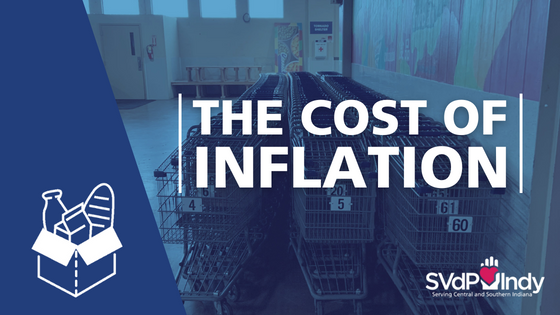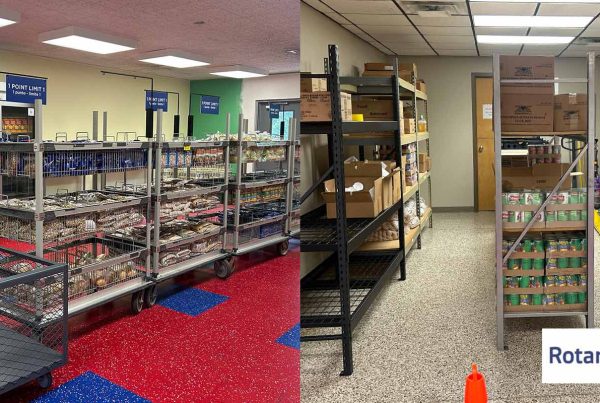By Peter Zubler, Executive Director
Most of us have watched our grocery bills inch upwards, week by week. In fact, according to the Bureau of Labor Statistics, the “food at home” category rose by 10% over the prior 12 months on the consumer price index—the largest increase since 1981! Translation: Many are feeling the pinch to monthly budgets and are having to make choices on how to manage through the tighter times.
We imagine that the current state of food prices is affecting what and how much food you buy for those around your table every week. Now imagine what it means to a food pantry that is feeding approximately 3,000 households each week. Like your food budget, ours has increased over the past year.
How We Get Food
To understand the impact, it’s important to first understand how we source food. We get our supply of food from food banks like Gleaners and Midwest, government programs such as TEFAP, or food brokers on the open market. Let’s look at each one:
- Food Banks: For many years, Gleaners received its food from retail donations—like Kroger, Meijer, etc.—or from wholesalers on the open market. Today, food banks aren’t receiving as many donations so they’re having to buy a higher percentage of food on the wholesale market. As a result, food pantries like us are impacted by both decreased supply and higher costs.
- Government Assistance: The Emergency Food Assistance Program (TEFAP) is a federal program that helps supplement the diets of low-income households. When COVID hit, this program was expanded greatly. Now, TEFAP has returned to its pre-COVID levels, lessening the support we previously received by about 60%. Yet, the needs of our neighbors are even greater than they were pre-COVID. In fact, just over a year ago, we got 90-95% of our donated meat from food banks and TEFAP. Today, this has dropped by half requiring us to purchase to make up the difference. The impact of that alone on our budget is significant.
- Open Market: Previously, a small portion of our meat was donated by meat processors. We did buy some to supplement our supplies—and if prices were high, we’d wait for them to drop again. Now due to reduced supply and increased demand, if we wait for the price to drop, we lose getting that food altogether.
The Perfect Storm
For food banks and food pantries, several negative events have coalesced to create the perfect—or rather very imperfect—storm:
- Food costs are increasing at exorbitant rates—we’re getting about 50% less than before with the same amount of spend. See the chicken example below.
- At the same time, the need for food assistance is climbing. We’re not just serving those faced with food insecurity, but also those needing budget relief. They come to us so they can allocate their money to rent, utilities or an unexpected expense like a car repair.
- Government programs launched during COVID have ended or will be stopping shortly—that means government assistance is back to pre-COVID levels, even though the needs today are far greater than pre-COVID levels.
- Demand is outweighing supply, which in turn, is diminishing our purchasing power or that of the food banks.
- In addition to the growing demand for assistance, fuel costs are at an all-time high and our utility costs are soaring. These problems are affecting manufacturers, which are the main source of large-scale donations at food banks. Transportation costs, for us and our suppliers, are significantly higher, too.
Meat: The Great Food Budget Disrupter
At SVdP, we don’t just want to provide food for our neighbors, we want to offer nutritious food that will nourish our neighbors’ bodies and minds. That means we focus on three key areas:
- Produce: We’re still able to get most produce for free from retail stores and food banks.
- Dairy: This is a combo area for us. We get some dairy products free, like milk from Gleaners, whereas other staples like eggs, we have to pay for. While we still purchase eggs at a discount, our price has risen 20%, which equates to $6,000 more a year.
- Protein: We’re still able to get many canned and dry goods through TEFAP, though quantities are reduced. Meat is the biggest area that affects our budget—and what was once affordable is now greatly impacting our budget.
Take chicken for example. Normally, chicken is both a healthy choice and the least expensive meat we can purchase for our neighbors who visit the pantry. But the price of chicken has jumped significantly from just a year ago. Last year at this time, chicken breast tenders were about $.80/lb. Now, the cost has almost doubled. A typical truckload of tenders has gone from $30,000 to $55,000.
- December 2021: $.80/lb.
- February 2022: $1.10/lb.
- July 2022: $1.47/lb.
Previously, when we purchased chicken or another meat from meat processors, the transportation costs to deliver this product to us would be covered by the processor. Now, with the price of fuel at record levels—along with the impact of supply chain issues—we’re now having to cover the entire cost of shipping and freight (transportation). Needless to say, our food pantry budget is largely impacted by the price of meat. So, as we’ve watched the prices of chicken and other meat climb, so has our food budget.
We’ve been able to maintain an annual food budget of about $300,000 or less for several years in a row. Now, in 2022, we project that we’ll top $400,000. That means we’re facing a shortfall. We’re also looking ahead to 2023 and believe the needs will be similar.
Consider Supporting Us
We’re so grateful to our donors for all of your support. We continue to be committed to being good stewards of the funds you’ve donated to us. We’ve managed as best as we can, but for all the reasons stated above, we need extra support. Our food costs have increased about 30%, so please consider giving a little more if you’re able. It will make a difference.





